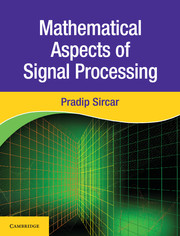Preface
Published online by Cambridge University Press: 23 July 2017
Summary
I have been using the material of this book for more than two decades while teaching a foundation level course on mathematical methods in signal processing being offered to the final-year undergraduate and first-year postgraduate students of Electrical Engineering at Indian Institute of Technology (IIT) Kanpur. Signal processing being an application area of mathematics, in order to motivate students to get involved in research of signal processing, it was felt that mathematics has to be presented in an informal and thought-provoking manner. In fact, the application area of signal processing is primarily concerned with the interpretation, interrelation, and applicability of mathematical concepts, whereas a formal course of mathematics is structured on treatise of existence, uniqueness, and convergence of mathematical results. Therefore, one has to relook at mathematics and find ways to make mathematical concepts go beyond abstractions and formal proofs.
My experimentation in teaching the above mentioned course has been quite rewarding. I have identified four areas of mathematics, namely, function representation, generalized inverse, modal decomposition, and optimization for our discussions. Mathematical concepts are frequently borrowed from these four areas for signal processing applications. However, the list of areas is not complete. Fundamental results of each area are presented in the class, followed by an interactive discussion of what can be their plausible implications. Finally, signal processing applications are showcased as illustrations of basic principles. Thus, the course serves the purpose of demonstrating how advanced signal processing applications are structured on basic mathematical concepts. I know a good number of students who credited the course, and subsequently decided to work on a research problem related to signal processing applications. The book will motivate students to develop a career in the broad area of signal processing as teachers, researchers or professionals.
During the year 1998–99, while I was visiting École Nationale Supérieure des Télécommunications (ENST) Paris, I started framing the idea of writing a book on the course material. I realized soon that it will not be easy to write a book on this subject. My lectures are more like discussion sessions, and the comprehensions are informal. In a few months time, I jotted down an outline of the proposed course, and drafted some sections of a chapter. However, I could not continue my endeavour after coming back to Kanpur because of other priorities. Nevertheless, the course material was constantly updated over the years.
- Type
- Chapter
- Information
- Mathematical Aspects of Signal Processing , pp. xvii - xviiiPublisher: Cambridge University PressPrint publication year: 2016



